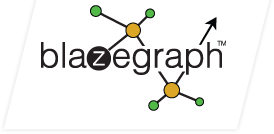-
Notifications
You must be signed in to change notification settings - Fork 170
Concepts
Graphs are a powerful and flexible means of representing all kinds of linked data. RDF is a data model that provides a standards-based way of describing, interchanging, and querying graph data. RDF models a graph as a collection of RDF statements. RDF statements which allow you to add vertices, edges, and vertex properties to your graph. RDR is a simple extension to RDF that allows you to add edge properties as well.
Blazegraph is a fully open-source high-performance graph database supporting the RDF data model and RDR. It operates as an embedded database or over a client/server REST API. Blazegraph supports high-availability and dynamic sharding, as well as both the Blueprints and Sesame APIs.
Vocabulary defines the concepts and relationships (also referred to as “terms”) used to describe and represent an area of concern. We’ll be referring to “vocabulary” as a collection of unambiguously defined terms, having consistent meaning in all contexts.
Taxonomy is a collection of controlled vocabulary terms organized into a hierarchical structure. Each term in a taxonomy is in one or more parent-child relationships to other terms in the taxonomy.
Ontology is a formal specification of a shared conceptualization. An ontology uses a predefined, reserved vocabulary of terms to define concepts and the relationships between them for a specific area of interest, or domain.
Inference is the act or process of deriving logical conclusions from premises known or assumed to be true.
Inference rule is a formal description of a type of inference, usually defined as entailments.
Entailment is a semantic relationship between expressions which holds whenever the truth of the first (or several) statement(s) guarantees the truth of the conclusion.
RDF - provides a way to model information in a form of named properties and property values. RDF is an assertional language intended to be used to express propositions using precise formal vocabularies.
- extends RDF by basic vocabulary, provides mechanisms for describing groups of related resources and the relationships between these resources.
OWL - extends RDFS vocabulary, can be used to explicitly represent the meaning of terms in vocabularies and the relationships between those terms.
RDF/RDFS and OWL are usually defined in inference engines as a set of predefined inference rules. Additional custom rules could be defined to provide custom entailments.
RDF is a standard model for data interchange on the Web. RDF has features that facilitate data merging even if the underlying schemas differ, and it specifically supports the evolution of schemas over time without requiring all the data consumers to change.
RDF extends the linking structure of the Web to use URIs to name the relationship between things as well as the two ends of the link (this is usually referred to as a “triple”). Using this simple model, it allows structured and semi-structured data to be mixed, exposed, and shared across different applications.
This linking structure forms a directed, labeled graph, where the edges represent the named link between two resources, represented by the graph nodes. This graph view is the simplest mental model for RDF and is often used in easy-to-understand visual explanations.
You could find more information on official Blazegraph™ web site, blog, and W3C Resources.

